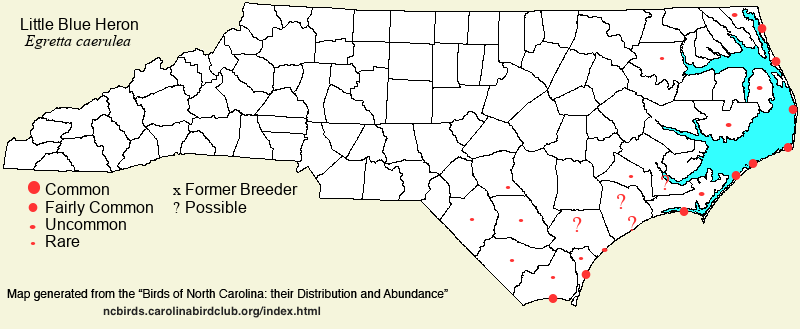 |  |
|
Little Blue Heron - Egretta caerulea ARDEIDAE Members: | Search Common: Search Scientific: |
|
|
|||||||
| General Comments | Despite the fact that adult Little Blue Herons are dark-colored, this species and the Snowy Egret are quite closely related (same genus), especially as first-fall and first-winter Little Blues are completely white in plumage and are easily confused with Snowy Egrets. And, their numbers along the East Coast are also in decline, though not as sharply as the Snowy, perhaps for the same reasons -- likely predation pressures at breeding colonies. However, there are some habitat differences between the two; whereas the Snowy has no aversion to salt water, the Little Blue tends to shun tidal waters, preferring fresh water pools, pond margins, and mudflats, though it does feed in brackish waters to an extent. Thus, the Little Blue is more likely to be seen farther inland than the Snowy, and there are a handful of inland nesting colonies. This species has an odd "quirk" not seen in most other species; in winter, it is the immatures that birders primarily see in North Carolina. For nearly all other bird species, the adults are the hardier age group, wintering farther north than immatures. | ||||||
| Breeding Status | Breeder | ||||||
| NC BRC List | Definitive | ||||||
| State Status | SC | ||||||
| U.S. Status | |||||||
| State Rank | S3B,S3N | ||||||
| Global Rank | G5 | ||||||
| Coastal Plain | Permanent resident along the coast, being migratory and thus more numerous in spring, late summer, and fall. Fairly common (but somewhat declining) along the entire coast, from Mar through Oct; locally common where numerous freshwater ponds are present. Numbers greatly reduced in winter; uncommon along the northern coast (Outer Banks), and uncommon to fairly common along the southern coast. Breeds on small coastal islands. In Tidewater, mostly uncommon to locally fairly common from Apr to Oct, nesting in a few sites; rare to uncommon in winter, and rare by late winter. Farther inland, generally uncommon post-breeding visitor from Jul to Sep; rare in spring, very local breeder (several sites), and casual in winter. Peak counts: 700 nests, and about 3,000 individuals, at a breeding colony on 7 Jun 1939, near Quitsna (Bertie) (Pearson et al., 1942). This reference indicates that the species was quite widespread and often locally common as a breeder in several areas in the central and eastern parts of this province. Sadly, today, it is quite rare as a breeder away from coastal sites. A colony of 30+ nests and 80 birds at a Bladen pond, as noted on 13 Jul 2024, is perhaps the largest inland colony in recent years. | ||||||
| Piedmont | Transient, though mainly a post-breeding visitor. Formerly fairly common, at least in the eastern portions (through the early 1980's), but at present mostly uncommon, Jun to late Aug. More numerous in the eastern part of the province, and rare to uncommon in the western Piedmont. Also, rare spring migrant in Apr and May, throughout the region. Essentially absent Oct to Mar, though an immature was photographed in southern Wake on 13-14 Feb 2016. Peak counts: 104, Falls Lake, summer 1983. | ||||||
| Mountains | Transient, though mainly a post-breeding visitor. Rare from mid-Apr to early Sep, essentially only in the southern mountains at low elevations, especially in Henderson. An immature along the New River at Brookshire Park (Watauga) on 24 Apr 2017 was quite notable in spring for the northern mountains. Peak count: 2. | ||||||
| Finding Tips |
This species is slightly less numerous than the Tricolored Heron and Snowy Egret, but you should be able to find the species near or along the coast from Mar to Nov. A handful of birds are found on most coastal CBCs; most are immature birds. Large lakes in Jul or Aug, where there are mudflats, are your best bests inland. *** | ||||||
| Attribution | LeGrand[2024-11-04], LeGrand[2017-12-08], LeGrand[2016-09-28] | ||||||
| NC Map Map depicts all counties with a report (transient or resident) for the species. | Click on county for list of all known species. |
| NC Breeding Season Map Map depicts assumed breeding season abundance for the species. |  |